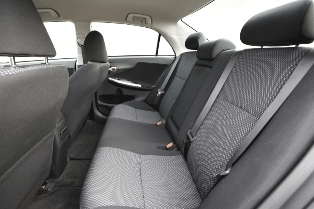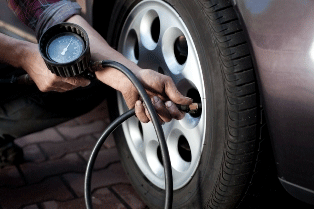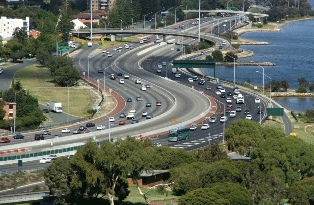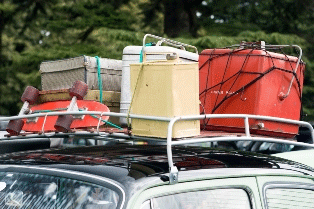5 easy ways to get the best fuel economy from your car
 While you have no control over gasoline prices, there are several steps you can take to increase your car’s fuel economy and spend less at the pump.
While you have no control over gasoline prices, there are several steps you can take to increase your car’s fuel economy and spend less at the pump.
In addition to saving you money, driving in a fuel-efficient manner may reduce global warming and slow the climate change that is affecting world weather patterns, conservationists say.
“It’s important to cut down the amount of gas we use and the amount of oil we have to drill out of the ground,” says Dan Becker, director of the Safe Climate Campaign environmental group.
One simple strategy is simply to drive less by relying more on public transportation. Ecologists such as Becker hope eventually to replace gasoline-powered cars with electric vehicles.
In the meantime, here are five tips for consuming less gasoline when you drive.
—-
 1. Remove extra weight from your car.
1. Remove extra weight from your car.
The more your car weighs, the harder your engine works, says Dave Cooke, a vehicle analyst for the Union of Concerned Scientists, a nonprofit science advocacy organization based in the U.S. If you make your car as light as possible, you can greatly improve your gas mileage.
To do this, you should avoid carrying any unnecessary items. For example, that old set of encyclopedias you’ve been meaning to take to the thrift store is making your engine less efficient while it sits in your trunk.
If you have a minivan with rear seats you’re not using, take them out until you need them. An extra 100 pounds can reduce your miles per gallon by up to 2 percent, according to FuelEconomy.gov, the fuel-efficiency website of the U.S. Department of Energy (DOE).
This reduction in efficiency adds up over time. For example, if you drove 10,000 miles each year, with a gas tank capacity of 20 gallons and a fuel consumption rate of 20 miles per gallon, you normally would consume 25 tanks of gas.
However, with the added weight in your car, you could consume 2 percent more fuel, a total of 25.5 tanks of gas during the year.
The additional 10 gallons you would need to buy to equal the extra half tank would cost you $35.90, based on an average national gasoline price of $3.59 per gallon, which was reported by the DOE on July 21, 2014.
Fortunately, automakers are also working toward making cars lighter. Dan Young, a spokesman for the CARSTAR network of auto collision repair shops, says car manufacturers gradually are moving away from steel and toward aluminum construction, which lightens cars and reduces fuel consumption.
—-
 2. Check the pressure in your tires.
2. Check the pressure in your tires.
You can improve your fuel efficiency by about 3 percent just by having properly inflated tires, says Dan Zielinski, a spokesman for the Rubber Manufacturers Association. You should check your tire pressure monthly, the association recommends.
“If your tires are underinflated, your engine has to burn more gas to get you where you want to go,” he says.
That’s because when the pressure is low, too much of the tire touches the surface of the highway, creating added friction. If the air pressure is too high, too little of your overinflated tire touches the road. This gives you less traction and makes your car less stable.
Typically, you can find a guide to proper tire pressure on a sticker in the driver’s side doorjamb, in the car’s glove box, or in your owner’s manual.
—-
 3. Maintain your car’s engine.
3. Maintain your car’s engine.
According to the Alliance to Save Energy, a coalition of industrial, technological and energy corporations, one of the best ways to save fuel is to keep your car running smoothly.
Don’t hesitate to see a mechanic if your engine begins running poorly, and never ignore the “check engine” light on your car’s dashboard. Getting an engine tuneup to improve fuel efficiency will cost you less in the long run, Becker says.
Cooke says you also should follow your auto manufacturer’s guidelines for oil changes.
“Regular oil changes are important because they help reduce engine friction,” he says.
When there is more engine friction, the engine must work harder to achieve the speed you want to travel. That causes it to burn more fuel.
—-
 4. Take it easy on the highway.
4. Take it easy on the highway.
One of the best ways to cut fuel consumption is to avoid aggressive driving. According to the DOE, aggressive driving — high speeds, rapid acceleration and hard braking — wastes gas. This driving behavior can reduce your mileage by up to 33 percent.
“If you floor it from a red light or a stop sign, you’ll use a lot more fuel than if you accelerate more gently,” Becker says.
Instead of rushing to reach your destination, start your trip earlier so you can take your time on the road. For example, the American Petroleum Institute says driving at 65 mph rather than 55 mph reduces fuel economy by about 2 miles per gallon.
—-
 5. Avoid hauling cargo on your car’s roof.
5. Avoid hauling cargo on your car’s roof.
If your car has a roof rack, hauling cargo in it will increase wind resistance and reduce fuel economy. You’ll get better mileage if you can fit your items inside the vehicle.
According to the DOE, a large cargo box on your car’s roof will reduce fuel economy by 10 to 25 percent at highway speeds of 65 mph to 75 mph. If you must use a cargo container at times, don’t forget to remove it when it’s not in use.
Your goal should be to make your car as aerodynamic as possible, Young says. Anything you attach to your car’s roof is likely to increase fuel consumption.
